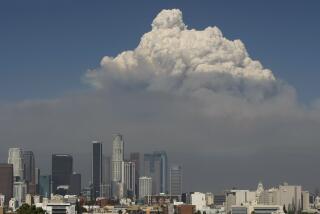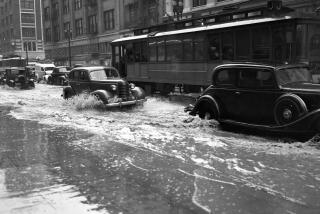‘There are three things you can do. . . . Clear your brush, trim away your dead branches or move.’ : When the Scary Winds Blow
There’s a stillness to the hours that precede them, a time when the whole world seems to wait. The dry grass stands motionless on the hillsides and not a leaf of the oak trees moves. Mountain dwellers nervously study the horizon and firemen fuss over their equipment. The very air crackles with tension. The wait feels endless.
Then the first winds blow.
They come whispering in off the desert, hot and dry and dangerous, sucking the moisture from the air and sending temperatures climbing steadily up the scale, like the rising intensity of a silent scream.
Their entry into the basin, at first timid brushes with the highest branches, soon builds to howling frenzy, and the winds fly through the fields and the canyons with a madness that matches their unpredictability, full of wild mischief and sudden bursts of temper.
A Topanga friend calls them the crazy ladies, firemen see them as the devil winds, we know them as the Santa Anas.
As we have seen, this is their time of year, when the pressure builds in the north and drops in the southwest and the crazy ladies come rushing downhill Al Martinez
through a door flung open at the Mojave by the dynamics in the atmosphere 20,000 feet up.
And they dance with a speed that sets the world on fire.
I was born in a thunderstorm, stood combat watch in a typhoon and wrote stories in a hurricane, but I’ve never seen winds quite so strange and scary as the Santa Anas.
I suppose a part of that is the quality of uneasiness that precedes their arrival and the caprice of their manner when they arrive. Trees bend first to the south and then to the west and then spin like witches at a ritual as las mujeres locas , the crazy ladies, dance by.
“You always know when they’re coming,” a county fireman said to me. “Everyone is on edge, you know? There’s something in the air, an energy or an electricity, that sets your hair bristling. All you can do is stand watch and wait.”
And when they do come, the fire bells almost always ring. They’re beginning to ring already for the Santa Monica Mountains, and no one knows where they’ll ring next. For along with the caprice of the gales comes the arsonist with the torch, responding to the special tensions the devil winds create. Like the ladies that dance to a music of their own, the fire-starter reacts to a passion in his head that only an inferno will satisfy. The love affair is a strange and fiery union.
“The Santa Anas become more dangerous every year,” the county fireman said. “Not because they’re any stronger or any more frequent, but because of where people are building their houses. When I first began fighting fires around here 28 years ago, you could burn 50,000 acres and not come anywhere near a home.
“Now there are almost always structures involved. The open spaces are going fast.”
I’m a canyon dweller. When the mornings are sweet and the nights at peace with the owls and the coyotes, I can well understand why I chose to build my house among the oak trees. Even when it rains so hard you can’t see your way up the hill, I’m glad I’m where I am and don’t mind the buckets that catch the water dripping through leaks in the roof.
Only when the Santa Anas come whirling through the passes that link them to the desert, and tendrils of smoke in the distance become firestorms in my neighborhood, do I stand like a peacemaker in a war zone, wondering at the prudence of my position.
Fire creates a calamity all its own. Stirred to savagery by the crazy ladies, it quickly becomes a catastrophe that leaves lives and timbers smoldering on the mountainsides, awesome reminders of the elemental nature of our environment. Live with the trees, die with the trees. Stake your claim and take your chances.
“There are three things you can do to help,” the county fireman said. “Clear your brush and trim away your dead branches.” The third? “Move.”
The ideal situation, I suppose, would be to have no houses at all in the mountains and on the hillsides, so that the fire and the wind could simply dance themselves out in the dry chaparral without endangering anything man-made. When homes are involved, the fireman’s job becomes more dangerous than it already is, for then he must extend himself beyond safety to preserve what we’ve built where we shouldn’t have built it.
But the ideal is rarely achieved, and we are left to rely on the firefighter’s bravery to stand with inadequate weapons between us and the forces of nature that periodically come to slap us around for the sake of diversion.
The winds of danger are here now. As I look out the window, high branches bend, leaves fly past and dust whirls across an open field. The air is swept clean of smog, and the pristine distance fakes the eye into believing the mountains are close enough to touch. They shimmer in the dry heat.
And the whole world waits for the crazy ladies to dance through.
More to Read
Sign up for Essential California
The most important California stories and recommendations in your inbox every morning.
You may occasionally receive promotional content from the Los Angeles Times.










